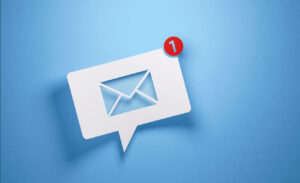Breaking the burnout cycle: Tips for streamlining communication and boosting workplace productivity
Employees are feeling overwhelmed and overloaded. But why?

Michael DesRochers is managing partner for PoliteMail.
According to a recent report by Gartner®, 27% of employees and 38% of managers feel overloaded by information. Twenty-three percent of employees — and more strikingly — nearly 32% of managers report experiencing a high information burden.[1]
The reasons for this are clear enough.
When the pandemic hit, most organizations had to improvise their transition from in-person to remote working models. Employees needed a reliable cadence of information. Employers did their best to deliver it by adding new communication channels into the mix.
But the unintended consequence of this rapid shift is that employees are being inundated with messages from every direction — phone, text, email, Zoom, Slack, Hub, Teamwork, and the list only grows from there.
So what can organizations do to address this issue? In this article, we’ll explain why information overload matters and offer practical strategies for reducing communication burnout and creating a healthier, more productive workplace for everyone.
The impact of communication overload
The consequences of communication overload can be severe and far-reaching.
Employees who are constantly bombarded with messages and notifications may experience high levels of stress, distraction, and fatigue, which can lead to burnout, decreased job satisfaction, and even physical and mental health problems.
The irony, of course, is that the same tools intended to streamline communication and spur creativity may actually impair collaboration, decision-making, and innovation as employees struggle to filter out irrelevant information and prioritize their tasks effectively. But it’s even more complicated than that.
As a Gartner recent report states, “Growing dependence on digital tools has given rise to two notable employee experience challenges:
· Digital friction: The unnecessary effort that employees must exert to use data or technology for work, which prevents them from achieving their full productivity potential. For instance, two out of three employees exert too much effort when using workplace technologies.
· Reciprocity Debt: Digital and relationship burdens employees [JM1] to feel compelled to keep up with more communication channels, responding to messages and social commitments to colleagues, and superiors.” [2]
So, what do we do about it?
Audit your apps
How many apps are your employees toggling between every day? Research from 2018 suggests they are using an average of four, but something tells us they might be using even more five years later. Why?
Often, when a department or team experiences a problem, they search for a shiny new digital solution to address it. Unless there is some oversight or an organizational approval process in place, departments purchase the tool, train their staff to use it, and everyone is happy — at least for a while. The trouble is that over time, the employee who introduced the tool leaves or is perhaps promoted.
Now multiply this situation ten or fifteen times. This may be the best explanation for how your organization ended up with so many apps — and, subsequently, so many dings and disruptive notifications.
First, look at all the apps your organization is currently paying for. Then ask your employees which apps they actually use and find valuable. Now get rid of any apps that aren’t helpful or just taking up space. It’s a simple way to clean up your software toolbox and keep things running smoothly.
Pare down and streamline workflows
Switching between tasks, or “context switching,” is mentally exhausting. Unfortunately, employees do a lot of context-switching, which slows down work and reduces focus.
In fact, a study of 20 teams across three Fortune 500 companies found that the cost of switching between apps is a little over two seconds, and the average user toggled between apps nearly 1,200 times per day. Add it up, and employees spend almost four hours a week reorienting themselves, with nine percent of their annual work time lost to context switching.
To eliminate context switching, consolidate your tech stack into a single, user-friendly platform. It may sound counterintuitive to fix an app-overload problem with another app. However, by adopting an app that serves as a central access point for existing technology, employees can access multiple tools without needing multiple logins or learning the nuances of each tool. This reduces app overload, streamlines workflows, and boosts productivity.
Make better use of the tools you already have
Rather than introduce new tools, make better use of those you already have. Email is a perfect example — while it isn’t new or flashy, it is still one of the most powerful, yet underutilized communication channels ever invented.
“One strategy that works is channel consolidation, not proliferation. Deploying new digital channels is not necessarily better than simply making better use of email and communication. Optimizing your audience segmentation, frequency, and message length plays a big part in grabbing attention, readership, and engagement. It may seem counterintuitive, but the analytics show it works,” says Michael DesRochers, founder and managing director of PoliteMail.
Here are a few things we’ve learned about email and engagement from our analysis of nearly 3 billion internal emails to over 12 million employees:
1. Segment and target the audience: One way to increase engagement and productivity is to segment and target the audience for your emails. Instead of sending a generic message to everyone, tailor your messages to specific groups of employees who are most likely to benefit from them. This can increase the relevance of your messages and make them more likely to be read and acted upon.
2. Be succinct: Long, rambling emails are less likely to be read and can contribute to communication overload. Instead, keep your messages short, focusing on one key idea or action item. Use bullet points or numbered lists to break up the text and make it more scannable.
3. Make your emails visually stimulating: Start with a template that compliments your brand and includes visual content like images, videos, and GIFs. This can make your email more engaging and memorable. Be sure to use high-quality visuals that are relevant to your message.
4. Keep it clean and simple: While making your emails visually appealing is critical, it’s also important to keep your design simple and clean. Avoid cluttered layouts, excessive text, and too many images. A clean design will make your email more professional and easier to read.
5. Start using PoliteMail: You can spend hours crafting an email, but how do you know if employees read it? We created PoliteMail to answer that question. Our tool gives you accurate engagement analytics, plus the ability to create responsive email templates as well as import and segment lists — all inside Outlook.
Encourage deep working time
We may work from the quiet of our home offices, yet the typical workday is loud. Why? Most of us are bombarded by the sights and sounds of desktop and smartphone notifications.
Notifications, such as email alerts, chat notifications, or app notifications, can significantly disrupt workflow. When employees are interrupted by notifications, getting back to the task at hand takes time, reducing their productivity and increasing stress levels.
While we may have bought the myth that we can multitask, research suggests that despite notifications only wasting 1/10 of a second of an employee’s time, they can also add up to a 40% loss in productivity throughout the day.
Encourage team members to turn off unnecessary notifications. Furthermore, provide guidelines and best practices for notification management by:
1. Setting times to check and respond to messages.
2. Creating filters and rules to prioritize important messages.
3. Turning off notifications for non-urgent communication channels.
4. Promoting a culture that values deep work and uninterrupted time to focus on important tasks.
Encourage effective communication using the right channel
Effective communication is crucial in any workplace, but it’s important to consider which communication channels are best suited for specific situations. Too often, we send messages without pausing to ask ourselves the following questions:
1. Is this message urgent, or can it wait until an upcoming meeting?
2. Do I need to keep a record of this information, or can I deliver it verbally?
3. Is this message confidential or sensitive in nature?
4. Am I communicating with an individual or a group?
5. Do I need to share this message with the entire team, or is it intended for a specific audience?
Asking these questions can help employees slow down and communicate intentionally using the most appropriate channel. Consider sharing this five-question exercise with your team and encourage them to use it before sending out communications.
Create employee personas — then segment your communications
Employee personas help organizations better understand their employees’ needs, preferences, and behavior. This information allows us to develop targeted communication strategies that are more relevant and meaningful to each group.
Ideally, you want to gather a range of information about employees, including job titles, location, values, beliefs, interests outside of work, and personal goals. It’s also important to document their communication preferences. For example, do they prefer email, phone, in-person communication, or Slack?
More specifically, are they more likely to engage with visual or written content? And what time of day do they intend to check their emails or messages?
You will also benefit from learning about their priorities at work. For example, what motivates them to perform, and what challenges do they face?
Next, use this information to create segmented lists. This allows you to better predict which messages each employee will find valuable.
Give more control the communications department
While HR and IT usually have access to employee data, they often lack a clear understanding of how their audience breaks down in terms of interests and needs. Because of this, these departments tend to be the worst offenders when it comes to sending long, irrelevant content to large groups of employees.
That’s why we suggest handing over organizational messages to the communications department. They deeply understand the employee audience and can use that knowledge to create targeted communication that resonates with different groups.
Sure, IT and HR should still control the base data, but the communications team will organize that data and package it for the targeted audience groups they want to reach. This way, employees receive communications that are relevant to them without being bombarded by irrelevant information.
Streamline communication with PoliteMail
Need a simple solution to overcome the communication challenges of remote and hybrid work? With real-time metrics like open rates, read times, and click-through rates, PoliteMail enables you to gauge team engagement and evaluate the effectiveness of your communications strategy — directly within Outlook.
Plus, PoliteMail’s template builder allows you to create visually appealing, mobile-responsive templates that look great on any device, leading to increased engagement and streamlined communication.
To learn more, click here!
[1] Gartner, Information Overload Is a Strategic Risk — And You Can Reduce It, Communications Research Team, 2 February 2023.
[2] Gartner, Modernize Employee Communications to Improve Digital Experiences and Workforce Engagement, Mike Gotta, Adam Preset, 22 June 2022






